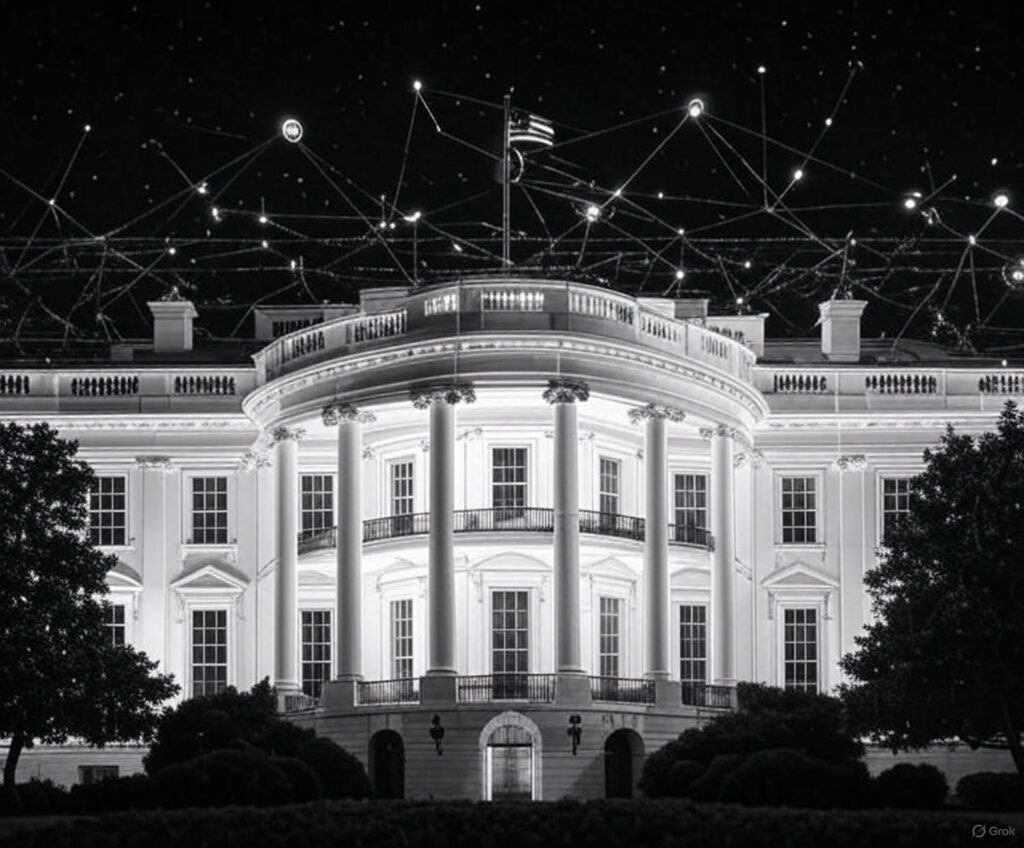White House announces digital assets report further solidifying its already mainstream legitimisation under the Trump Administration.
The report, reportedly mentions crypto 391 times, Bitcoin 130 times, DeFi 32 times and Ethereum 28 times. Putting crypto at the heart of the report.
The report starts outlining the responsible growth of the digital asset industry and blockchain technology outlining the policy of this administration in an executive order in the 5 following points:

(i) protecting and promoting the ability of individual citizens and private-sector entities alike to access and use for lawful purposes open public blockchain networks without persecution, including the ability to develop and deploy software, to participate in mining and validating, to transact with other persons without unlawful censorship, and to maintain self-custody of digital assets;
This policy point ensures that individuals and entrepreneurs engaging in lawful activities on open public blockchain networks, such as developing software or transacting privately, are protected from unjust prosecution. The Silk Road case, though involving illegal activities, demonstrated how blockchain’s transparency can lead to intense legal scrutiny, even in the early days of cryptocurrency when regulations were unclear. Similarly, the Samourai Wallet case, where developers faced charges for creating non-custodial privacy software despite arguments that no money transmitter license was required, underscores the ongoing risk of legal overreach. These cases highlight the need for clear legal protections to foster crypto innovation without fear of persecution.
(ii) promoting and protecting the sovereignty of the United States dollar, including through actions to promote the development and growth of lawful and legitimate dollar-backed stablecoins worldwide;
This policy point ensures there is no ambiguity about stablecoin and the sovereignty of the U.S. Dollar, understanding that the promotion growth and development of stablecoin’s is key to the Dollar’s continued success and dominance.
(iii) protecting and promoting fair and open access to banking services for all law-abiding individual citizens and private-sector entities alike;
This policy addresses concerns about debanking, where financial institutions deny or terminate services potentially due to political or ideological reasons. Notable examples include Kanye West’s debanking by JPMorgan Chase in 2022, allegedly tied to his controversial statements, and Donald Trump’s alleged debanking by Capital One. Or across the pond Nigel Farage’s high-profile debanking by Coutts in the U.K. (a NatWest Group Subsidiary), where internal documents cited his political views as a factor. In the U.S., claims of politically motivated debanking, such as those affecting conservative figures or digital asset firms under alleged “Operation Choke Point 2.0,” highlight the need for this policy. Although the finer detail likely needs an act to substantiate it, we are hopeful that this will serve as the bedrock for the western world.
(iv) providing regulatory clarity and certainty built on technology-neutral regulations, frameworks that account for emerging technologies, transparent decision making, and well-defined jurisdictional regulatory boundaries, all of which are essential to supporting a vibrant and inclusive digital economy and innovation in digital assets, permissionless blockchains, and distributed ledger technologies; and
This policy point is the lifeblood of the impending crypto boom. For too long, the industry has laboured under unclear and inconsistent regulations, leaving prominent figures like Changpeng Zhao of Binance vulnerable to an overzealous U.S. administration perceived as anti-crypto. The crypto community is united in its ambition to build a robust onchain economy, with countless innovators working around the clock, worldwide, to ensure blockchain integrity and combat bad actors. Clear, fair regulations are essential to unleash this potential and drive transformative growth.
(v) taking measures to protect Americans from the risks of Central Bank Digital Currencies (CBDCs), which threaten the stability of the financial system, individual privacy, and the sovereignty of the United States, including by prohibiting the establishment, issuance, circulation, and use of a CBDC’s within the jurisdiction of the United States.
The United States must take decisive action to shield its citizens from the dangers posed by Central Bank Digital Currencies (CBDCs), which jeopardised financial stability, erode personal privacy, and undermine national sovereignty. By prohibiting the creation, issuance, circulation, and use of CBDCs within its jurisdiction, the U.S. can champion the decentralised ethos of cryptocurrency and blockchain technology. Unlike CBDCs, which enable centralised control by a few institutions often prioritising self-interest over the public good, stablecoins foster a competitive, innovative monetary system. This bold policy ensures decentralisation takes root, empowering a resilient financial future free from the failures of past centralised crises.
Conclusion
These 5 policy points bring clarity to areas of crypto that have long held the industry back and ensure the crypto revolution is in full swing proving clarity to lawful protections for entrepreneurs, stablecoins and CBDC’s, debanking and the need for a fair access policy for banking and digital banking, regulatory clarity to ensure clarity on things like staking and other crypto related activities and presentations for the corruption of decentralisation through centralised control.
